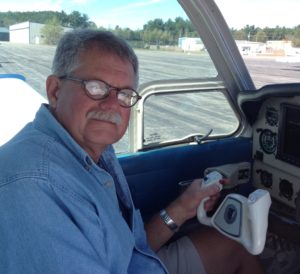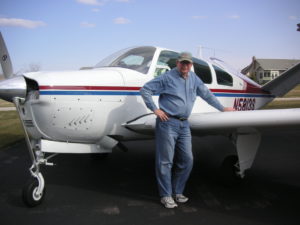Craig Bailey
CFIAIME, ATP, A&P, IA
Recently, BPT TAKEOFF visited with BPT Instructor Craig Bailey. In addition to being a Flight Instructor [Airplane, Instruments and Multiengine], Craig is an Advanced and Instrument Ground Instructor and FAA Safety Counselor; Multiengine ATP; Airframe and Power Plant Mechanic with Inspection Authority.
 BPT: How did you become involved in aviation?
BPT: How did you become involved in aviation?
CB: Interestingly, I didn’t come from an aviation family, so I did not have “aviation” in my DNA. My interest came more from the desire to travel, experience new things and the adventure and beauty of seeing the world from a different perspective. Whenever my parents would drive past an airport I would ask them to turn in so I could look at the planes and dream about where the planes would take the pilot and passengers next.
BPT: When and where did you learn to fly?
CB: While on summer break between my sophomore and junior year at Iowa State University, I learned to fly at the Mason City Municipal Airport. I worked during the day doing road construction and drove thirty miles to the Mason City Airport several times a week to learn to fly. I received my Private certificate the day before I went back to school to start my junior year.
BPT: What aircraft do you own — and what have you flown in the past?
CB: I have continuously owned a model 35 Bonanza for the last 35 years. Over the years I have owned a C35, an H35 and for the last 21 years I have an S35 Bonanza. In addition, I own a 1936 Waco cabin biplane, model YKS-6.
I have been very fortunate over the years to have flown a multitude of general aviation aircraft. In the Beechcraft line I have flown the Sierra, every model 35 Bonanza from a very early serial number 1947 Bonanza through the V35B. All four and six passenger straight tail Bonanzas along with the 55 and 58 Barons and Debonairs. Cessna 120, 140 150, 152, 170, 172,172RG, 177, 177RG, 180, 182, 210, 310. Piper PA-12, PA-15, PA-28: 140, 160 180, 181, 235, 201R, PA-32 and 32R. Aeronca 7AC, American Champion models KCAB, GCBC and KECA, Bellanca Vikings, Taylorcrafts, and, of course, my Waco YKS-6.
BPT: Our readers would like to hear about some of the highlights of your flying career. Would you share those with us?
CB: General aviation has enriched my life in so many ways. Over the years my wife and I have meet so many wonderful folks through aviation, many of them are now some of our closest friends. Flying has allowed me to travel throughout the United States, Canada including Nova Scotia and many islands and cays in the Bahamas. Many of these trips could not have been done without an airplane. As a flight instructor many of my best aviation memories center around the joy of helping folks reach their aviation goals whether it be their first solo or obtaining that new certificate or rating.
BPT: Tell us how you became involved with BPT, Craig.
CB: Shortly after I purchased my H35 I decided to attend the weekend program. I wanted to know as much as I could about the plane and how to fly it. I contacted the Administrator, Sam James and told him I had enrolled in the upcoming program and had an interest in being an instructor in the program. He paired me with Bill Hale for my training. That was in 1989 and I have been an instructor in the program since that time.
I believe that BPT provides an outstanding opportunity for the Beechcraft owner / operator to become a better and safer pilot. In addition BPT is the only program offering a companion course to help your right seater become part of the team. BPT was established to make flying in a Beechcraft a more enjoyable and safer experience. There is nothing better than to see participants leave this weekend experience with new confidence in their abilities.

BPT: Many training options are available to pilots, Craig. What do you believe makes BPT unique?
CB: The background and depth of knowledge of the instructors coupled with the in classroom experience makes BPT unique. Instructors are there because they have a passion for flying Beechcraft and want to share their knowledge. BPT instructors come to the classroom from the military, airlines, corporate and general aviation. With the blend of different aviation backgrounds and training, BPT is able to provide a high level of training helping the customers to raise the bar in their flying abilities.
In addition, the classroom setting provides many opportunities for customers to learn from their classmates both during class as well after class.
BPT: Would you recommend BPT to a new pilot?
CB: Absolutely. To be a safe pilot, type specific flight training is a must. BPT gives a pilot the skills and knowledge to safely operate their aircraft. Many of the skills and techniques taught by BPT have been developed over thousands of hours of training pilots in these planes along with significant input from Beech specific maintenance providers. In any endeavor, we all want to be the best we can. Enrolling in a BPT weekend program is one of the best ways to provide a new Bonanza or Baron pilot with the information and skills they need to safely operate their aircraft.
BPT: Is BPT helpful for the more seasoned pilot?
CB: Without a doubt. It is important to regularly have someone look over our shoulder to see if we have unknowingly developed some bad habits as well as to get feedback on our overall flying skills. Our flying skills erode over time at a much more rapid rate than we realize. Regular training helps keep our skills up and provides opportunities to learn new things. In addition I believe we all need to occasionally be nudged out of our comfort zone, to experience things we would not otherwise practice on our own so we are better prepared to handle unusual situations should they arise.
BPT: What else would you like to add?
CB: Sometimes I think folks don’t take advantage of flight training programs like BPT because they don’t know what they don’t know or they are afraid or concerned about being critiqued. Every year BPT sees a wide spectrum of flight customers from pilots with thousands of flight hours to the newly-minted pilot. Each and every one of those flight customers has one basic goal and that is to become a better, safer pilot. That is what BPT is all about. I always like to tell folks, “No matter what level you are at, we will help you reach that next level in your flying skills.”



